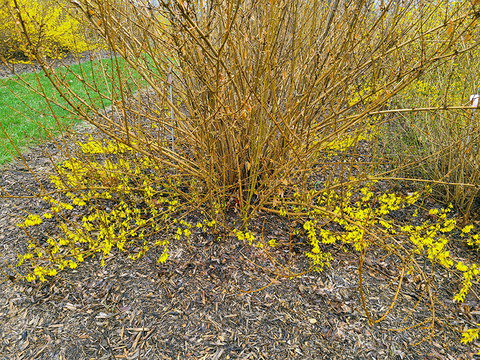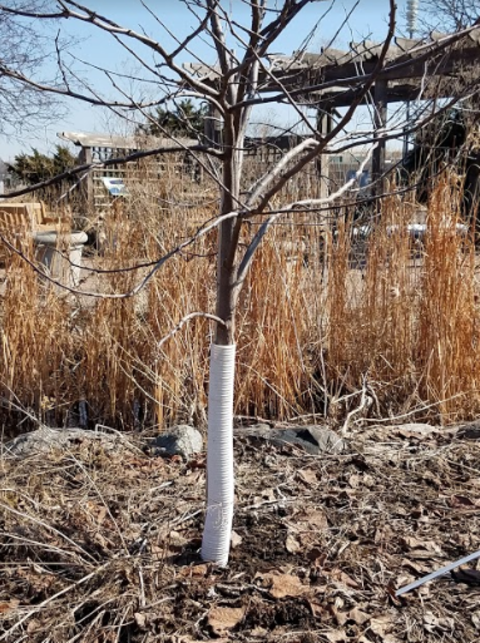You have to be tough to be a plant in Minnesota. Our plants endure cold, heat, humidity, flooding, drought, insects and weather extremes like hard-driving rainstorms and wind.
But even the toughest plants can be damaged by winter with its fluctuating temperatures, intense winter sun, and desiccating wind.
Here are two types of the common types of winter damage and what you can do to protect your plants and help them recover.
Sunscald
Sunscald is characterized by elongated, sunken,dried or cracked areas of dead bark usually on the south-southwest side of a tree with thin bark. It occurs when intense winter sun heats up tree bark and stimulates cell activity within the tree trunk or branch. When a cloud, hill or building blocks the sun, the bark temperature drops rapidly and the active cells in plant tissue are killed and the bark cracks forming a frost crack.
Trees susceptible to sunscald are younger trees and newly planted trees, and thin-barked trees such as cherry, crabapple, honey locust, linden, maple, mountain ash and plum. Older trees have thicker bark that insulates and keeps tissue dormant and cold hardy.
Trees that have been pruned to raise the lower branches or transplanted from a shady to a sunny location (the lower trunk no longer shaded) are also susceptible to sunscald.
How to repair sunscald damage
The good news is that trees typically heal themselves by producing new growth of the inner bark or along edges of the split. As a tree owner, you can help by caring for your tree throughout the growing season to promote plant health and healing.
If you need to repair sunscald damage:
- Use a sterilized sharp knife to remove dead bark to reveal live tissue.
- Leave the wound uncovered.
- Spray fungicide if the tree is known to be susceptible to fungal diseases.
How to prevent sunscald
- Wrap the trunks of young and thin-barked trees with white guards or wrap.
- White reflects the sun and keeps bark temperature constant.
- Wrap or install guards on:
- Newly planted trees for two winters or longer.
- Thin-barked species for five winters or longer.
- Wrap your trees in the fall and remove the guards in spring after the last frost.
- Don’t use dark tree wrap or dark colored tree guards as they absorb heat from the sun and warm up the tree’s tissues, increasing cell activity.
Winter dieback
Winter dieback is the loss of stems, shoots, buds and sometimes entire branches of trees and shrubs due to winter cold and winds. Most common are shoots and buds of deciduous shrubs with flower buds being the most susceptible winter injury. Some plants, like some Forsythia, have cold hardy stems and leaf buds, but their flower buds are killed by cold winter temperatures. Other plants may lose entire branches to winter dieback.
Our winter temperatures and conditions vary in Minnesota. Because of this, there is not much that can be done to protect trees and shrubs from dieback. However, you can take management steps to reducing dieback.
Choose hardy plants with growing requirements that match your site conditions.
Study your landscape and select plants that will grow well in your existing soil, light, space and exposure. The Plant Elements of Design plant selection tool can help you match up the right plants for your landscape.
Providing optimal growing conditions for your plant:
- Reduces plant stress.
- Speeds up establishment after transplanting.
- Reduces plant maintenance.
- Improves plant performance and longevity.
Locate marginally hardy plants in sheltered locations.
Our landscapes can be great places to “push the zone.”In other words, try growing plants that are listed as hardy in a slightly warmer zone; for instance, try planting a Zone 5 plant in your Zone 4 landscape. If you choose to take this risk, locate marginally hardy plants in an area that is protected from winter sun and winds.
Avoid pruning, fertilizing and overwatering in late summer.
Pruning and fertilizing late in the season promote new growth that will not have time to acclimate to the winter ahead. While regular watering is important to plant health, overwatering in fall can stress plants. This can reduce winter survival and increase dieback.



